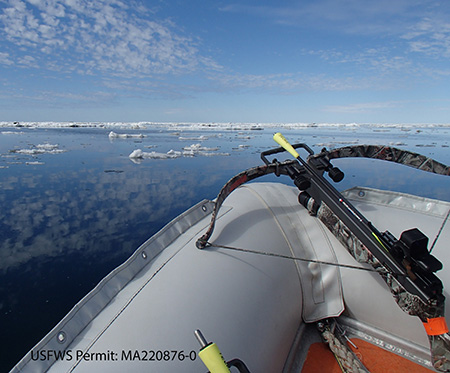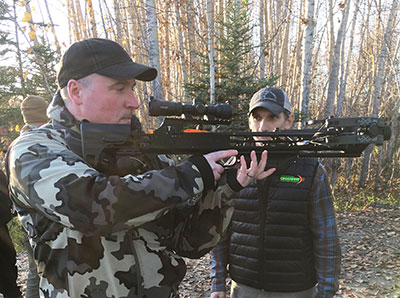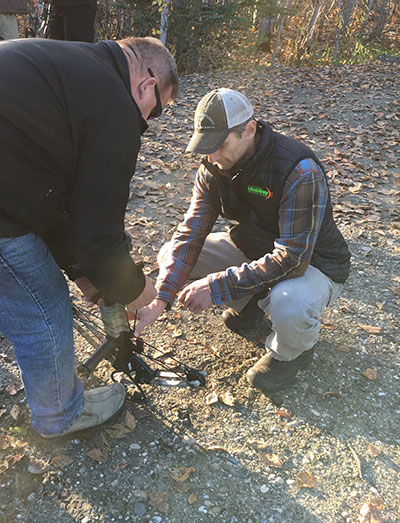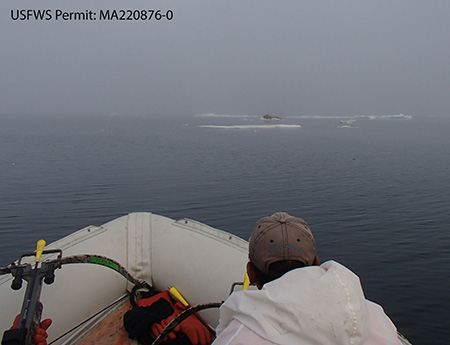Alaska Fish & Wildlife News
February 2018
Crossbows in Alaska

For many people, a crossbow is something only seen in shows about medieval combat or dystopian survival. But a crossbow is the tool of choice for some hunters, and biologists use them to shoot arrows that collect tissue samples or deliver tracking devices to marine mammals like walruses, sea lions and whales.
The image of a crossbow as a powerful, shoulder-fired weapon is accurate. And crossbows themselves are famously accurate at close range. The effective range is similar to a recurve bow or a compound bow, basically 20 to 60 yards, but the arrow is shorter and heavier. Most modern crossbows have scopes.
Beginning this year, Alaskans will have the opportunity to take a crossbow education course, and hunters using crossbows will be required to pass the course. Fish and Game’s Hunter Information and Training (HIT) Program recently trained 50 instructors to teach the course, and more will join the ranks this year. Many of the instructors already teach bowhunter education and are experienced archers and bow hunters.
Chris Alderman is a bowhunter and a crossbow instructor, and owns Screaming Eagle Archery in Wasilla. He said both his six-year-old son and his nine-year-old daughter shoot a crossbow.
“My kids started on crossbows because they didn’t want to the noise and recoil of a rifle,” he said. “They grew up in a bow shop, they can shoot indoors here, or at home in the garage; it doesn’t take much, you don’t have to buy bullets, and you don’t need to go out to a range.”
His daughter has harvested deer and black bear with hers. “She’s getting big, so we’re moving into a compound bow,” he added.
Another perception most people have about the crossbow is that the bow string is drawn and locked (cocked), the arrow is loaded, and the shooter pulls a trigger. Cocking the crossbow takes effort, and Alderman does that for his kids. Mechanical aids are usually used, involving a lever, cords, or cranks, depending on the style (recurve or compound) and the draw weight.
To hunt big game in Alaska with a compound bow, the draw weight must be at least 40 pounds, and at least 50 pounds for bigger animals such as moose and muskox. A crossbow is required to have a draw weight of at least 100 pounds. Alderman said the crossbows he sells have a draw weight of 185 pounds. The higher draw weight compensates for the much shorter limbs on the crossbow.
Beginning July, 1, 2018, all hunters using a crossbow to hunt in Alaska must successfully complete the crossbow certification course. The requirement was proposed to the Alaska Board of Game with the support of the Alaskan Bowhunters Association, and adopted by the board.
Ginamaria Smith, the HIT program coordinator, said the course was developed with an emphasis on the safety aspects specific to crossbows. Students take the first part of the course online, and after passing a written test, attend a field day with an instructor. A student is certified after passing a shooting proficiency test that involves shooting at four, three-dimensional animal targets, making five out of eight shots in the vitals at various distances less than 30 yards. Students must bring their own crossbows.
Smith said the HIT program will begin offering field days in April. Trained instructors are in place in Anchorage, the Mat-Su area, Fairbanks, Juneau and Kenai, and more field days in more places will be added over time.
“It was interesting when we were doing the instructor training,” Smith said. “At least a dozen of the instructors do own crossbows. But although the majority of the instructors are bowhunters, and some are instructors in other disciplines, most are not crossbow hunters. People came in with misconceptions or preconceptions.

Smith is a bowhunter herself, and was surprised by a couple aspects of the crossbow. “They are heavier than a compound bow, and bulkier, and they’re a lot louder than a compound or recurve bow. I was also surprised by the ease in sighting in the crossbows.”
Jeff Jemison is an experienced bowhunter and hunter education instructor. He manages the Juneau Indoor Shooting Range for Fish and Game, and last fall, he became a certified crossbow instructor. He had shot a small, light crossbow before, but the class was his first opportunity to handle a hunting crossbow.
“I was surprised,” he said. “They’re pretty complex, and they’re powerful. I was surprised at how heavy it was, and how hard it is to pull the string back. You have cocking aids, of course, but it was different than I expected. It’s a little more dangerous than people realize, you really have to hold it properly, and respect it.”
He said someone recently walked into the Juneau range with a newly acquired crossbow and asked to shoot. Jemison gave him directions to the nearby outdoor archery range, and they started talking.
“He bought it from a friend, there was no user’s manual, and he had no idea how to use it,” he said. “He was ready to go fire that thing with no information so I said, ‘hold on,’ and I copied a page out of our instructor’s manual, the safety checklist called the Visual Crossbow Inspection List. It’s something we go through in the class, you look over the limbs for cracks, inspect the arrows for damage, make sure they are the appropriate size, and make sure the strings aren’t frayed or damaged.”
As they inspected the crossbow, Jemison realized the man had bought the wrong arrows.
“They didn’t match the crossbow, and it’s important,” he said. “It’s like with a shotgun - you don’t want to drop a 20 gauge shell in a 12 gauge shotgun. They have to match.”
Crossbow arrows used to be called bolts, and some people still use the term, but Smith said the archery industry has switched to the term arrow. “They changed the phrasing so they can be included in the excise tax on archery equipment that provides funds to wildlife restoration and hunter education programs across the country,” she said. “In our course we call them arrows, but the regulations still refer to them as bolts.”
The crossbow projectile is about 20 to 24 inches long, as opposed to an arrow 27 to 32 inches long for a compound or recurve bow.
Hunting with a Crossbow
There are no special crossbow areas, seasons or hunts in Alaska. Some states do have crossbow seasons in addition to rifle and archery only seasons. The Alaska hunting regulations state: “In any hunt or area specifically restricted to bow and arrow only, you may not hunt with a crossbow.”
So crossbows are legal for regular hunts, but not “weapons restricted hunts.” However, in Alaska, it’s possible to apply for a method and means exemption, and use a crossbow in a weapons-restricted (archery-only) hunt. State permit biologist Brynn Parr said a hunter needs to fill out a one-page form providing information on what exemption they are asking for, and why they need it, and they need a doctor to write a physician’s statement and sign the form. She said about 40 or 50 exemptions are issued each year.
Like all archery hunters, “exempted” hunters are required to pass the bowhunter certification course, and when the crossbow certification requirement goes into effect July 1, 2018, they will also need that certification. For a resident hunter, the exemption is good for five years, however this year, all the exemptions will essentially expire, and will be re-issued when the hunters document that they have taken the crossbow certification course. Nonresident exempt crossbow hunters also need to meet the two certification requirements, and their exemption is only issued for the duration of the calendar year.

The hunting regulations specify: “You MAY NOT use a crossbow: For big game UNLESS the crossbow is at least 100 pounds peak draw weight; the bolt is at least 16 inches in overall length, tipped with a broadhead, and at least 300 grains in total weight; the broadhead is a fixed, replaceable or mechanical/retractable blade type and not barbed. No electronic devices are attached to the crossbow, except scopes or electronic sights that do not project light externally; the crossbow is shoulder-mounted.”
So why hunt with a crossbow?
“A lot of the guys in the state that want to hunt with them are handicapped guys that have grown up hunting with bows,” Alderman said. “They still want to go out with stick and string and arrow, but they don’t have the power or energy any more, or they don’t see as well, and they want a scope.”
Barb Terry is an avid hunter and archer in Ohio. She’s on the board of the National Bowhunter Education Foundation and is the Customer Relations Coordinator for TenPoint Crossbow Technologies. “I hunt with a crossbow, and a longbow, I bowfish with a recurve, and hunt with muzzleloaders and shotgun,” she said. “Ohio is not a rifle state.”
She prefers a crossbow for cold-weather hunting, because it’s harder to draw a bow and use “vertical” archery methods when she’s bundled up in bulky warm clothing.
She also guides beginning hunters who are equipped with a crossbow. “I work with a lot of special needs and handicapped folks, and I can get them out into the woods hunting for the first or second time,” she said. “They’re not left behind because they can’t pull a bow back.”
The regulations regarding hunting with a crossbow vary widely across the country. “In Ohio, it’s archery season whether it’s a crossbow, a recurve bow, or a compound bow. It’s seamless,” Terry said. Ohio’s fall and early winter hunting season also includes a shotgun season, a muzzleloader season, and a youth hunt season.
As of 2017, crossbows are legal for use in archery seasons in 26 states. They are legal in firearm season, but not archery season, in 10 states. They are considered illegal hunting equipment in Oregon. Some states offer a crossbow hunting season within the regular archery season, or allow their use for physically challenged hunters, or senior hunters over a certain age.
Terry has been tracking regulation changes nationally since 2003, noting that overall many states have allowed for broader use of crossbows.
Crossbows and Research
Wildlife biologist Justin Crawford has fired a crossbow thousands of times to collect tissue samples from walruses, and to tag walruses with satellite transmitters. He’s a researcher with the state of Alaska’s Arctic Marine Mammal Program. He said using a crossbow to collect a sample or deploy a transmitter has advantages over capturing an animal.
“We don’t have to handle the animal, we don’t have to touch it, we don’t have to immobilize it with drugs, and we don’t endanger ourselves,” he said. “It’s amazing to be able to get this incredible information. I used to collar bears, and that’s a lot more stressful for the animal.”

Crossbows are also used to get genetic samples from beluga and bowhead whales, and Steller sea lions, he said.
Crawford is based in Fairbanks and works in very remote, difficult-to-access locations in the Arctic. Once on the water, a team in a boat stealthily approaches a group of walruses hauled out on ice, careful not to alarm the animals. He described crouching down, peeking over the side, as the boat gets within 30 meters of the walrus. He aims for the back, avoiding the face and belly areas.
He uses an over-the-counter recurve style hunting crossbow with a special arrow. It looks like a normal arrow, but the front quarter is a foam float device. The tip has a bolt and a biopsy punch is threaded on. Three little prongs on the inside of the tip hold a piece of skin about the size of a pencil eraser.
“It hits the skin and pops off,” he said. “We just boat over and pick it up. The range is about 20-30 meters; we don’t want to get too close.
An arrow that is equipped with a transmitter is heavier, and Crawford said it drops more over the shooting distance, so they get within 10 to 15 meters. A spade anchor holds the transmitter in place.
“A walrus has very thick skin and a lot of blubber,” he said. “We try to attach the tag between the shoulder blades, the tag hits there and holds, in the blubber, there’s enough energy in the shot, and then you have a transmitter sitting there on the surface of the skin.”
“The transmitter provides location data, haulout data; and we know when the animal comes up out of the water on the ice to rest. About half the transmitters provide data on how deep the animal dove, and how long they stay under. The device lasts one to four months – not very long. Walruses are big gregarious animals that rub up against each other, and against the sea ice, so the tags break. If it sat on your shelf in the window, it might last nine months.”
He said some walruses don’t even notice they’ve been tagged or hit with the skin biopsy arrrow. “If they’ve been swimming and they’re hauled out on the ice sleeping they’ll be tired and won’t even raise their head, or they might look and they think another walrus bumped them, and then they put their head back down.”
This work was a collaboration among ADF&G, which headed the tagging project; the US Fish and Wildlife Service, which headed the collection of samples for a mark-recapture project; and the USGS. More than a thousand samples a year have been collected over the past several years. Mark-recapture is a method biologists frequently use to estimate the size of a population. This study will also provide insights into the age structure of the walrus population.
Crawford said he practices shooting before the season, and he and his colleagues practice on the deck of the ship as they access the study areas. He appreciates the accuracy of the crossbow.
“You can hit the animal right where it’s safe,” he said. “If you keep them maintained and properly sighted in you can hit a nickel from 30 meters.”
More on walrus tracking and Alaska’s marine mammal research
More on crossbow safety education, including a good video:
To learn more or to sign up for ADF&G’s crossbow education certification course, or contact (907) 267-2196 for additional information.
Subscribe to be notified about new issues
Receive a monthly notice about new issues and articles.
